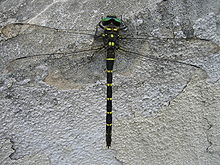- Cordulegastridae
-
Cordulegastridae 
Anotogaster sieboldii Scientific classification 
Kingdom: Animalia Phylum: Arthropoda Class: Insecta Order: Odonata Suborder: Epiprocta Infraorder: Anisoptera Family: Cordulegastridae Genera[1] - Anotogaster Selys, 1854
- Cordulegaster Leach, 1815
- Neallogaster Cowley, 1934
- Sonjagaster Lohmann, 1992
The Cordulegastridae are a family of Odonata (dragonflies) from the suborder Anisoptera. They are commonly known as Spiketails.[2] Some vernacular names for the species of this family are biddie and flying adder[3]. They have a large brown or black body with yellow markings. They can be found along small, clear, woodland streams, flying slowly 30 to 70 cm above the water. When disturbed, however, they can fly very rapidly.
The Cordulegastridae usually lay their eggs in the sand in shallow water, the female hovering just above the water with her body in a vertical position, and making repeated dips into the water with her abdomen.[4]
The family is distributed world-wide; all eight species in North America belong to the genus Cordulegaster.[3]
The name Cordulegastridae comes from the Greek kordylinus, 'club-shaped' and gaster, belly. The common name spiketails refers to the females' prominent ovipositor.[2]
References
- ^ Martin Schorr, Martin Lindeboom, Dennis Paulson. "World Odonata List". University of Puget Sound. http://www.pugetsound.edu/academics/academic-resources/slater-museum/biodiversity-resources/dragonflies/world-odonata-list/. Retrieved 11 August 2010.
- ^ a b Berger, Cynthia (2004). Dragonflies: Wild Guide. Stackpole Books. ISBN 0811729710.
- ^ a b Tim Manolis, Timothy D. Manolis: Dragonflies and Damselflies of California (California Natural History Guides (Paperback)). University of California Press, 2 November 2011, ISBN 0520235673, p. 40.
- ^ Donald Joyce Borror, Dwight Moore DeLong. An introduction to the study of insects. ISBN 9780030828614.

This article related to dragonflies is a stub. You can help Wikipedia by expanding it.
